North Carolina is home to a diverse habitat that is home to many Southeastern frogs and toads.
The state has more than 30 species of frogs and toads. Most are native while others such as Cuban Frogs are invasive.
Frogs and toads carnivores, omnivores, or insectivores here. They are also food for species such as Black Racers and Garter Snakes.
Table of Contents
Are There Poisonous Frogs and Toads in North Carolina?
Pickerel Frogs and Flower’s Toads are among the species with skin toxins secretions.
Touching these species leads to irritation in most cases. Watery irritated eyes and even small breathing difficulties are reported by some people handling these frogs and toads.
Many predators know how to avoid these types of toads and frogs as well. Still, these aren’t the most numerous frogs and toads in the state as there are snakes and birds which can eat even these toxic frogs and toads.
Frogs and Toads in North Carolina
The following species have established populations across the state with stable numbers and no endangered status (except endangered Gopher Frogs).
1. Green Treefrog

Green Treefrogs (Hyla cinerea) come in different dorsal colors such as green or brown. Most frogs of the species have a light green color in the state.
Green Treefrogs are found in or next to permanent bodies of water in North Carolina.
They feed on flies as mosquitoes as an insectivore species here.
Known for their climbing abilities, these frogs can call when advertising their territory or when looking for a prospective female mate.
A nasal-like waak call is specific to the species. This call is repeated 50 to 75 times per minute.
This is a species that forms choruses, an aggregation of males with slightly distinct calls.
2. Cope’s Gray Treefrog

Cope’s Gray Treefrogs (Hyla chrysoscelis) have diverse coloring, from gray to green. An orange section is spotted on its inner legs as a distinctive trait.
This is a species with a long mating season in North Carolina. It lives in woodlands where males can begin calling even before moving to a body of water to form choruses.
While sporadic, these calls in woodlands are still louder than in other species.
These are chiiirp, chiiirp sounds that highly resemble bird chirping.
Coming in direct contact with Cope’s Gray Treefrogs isn’t recommended as some people have allergic reactions to them. This includes irritating eyes and skin irritation.
3. Squirrel Treefrog

Squirrel Treefrogs (Hyla squirella) grow to an average size of 1.5 inches. These are some of the typical frogs of the South East and North Carolina.
High aggression levels are characteristic of the species, a known insectivore outside of its tadpole stage. Its tadpoles feed on organic matter scrapped from rocks.
This species comes in different colors. Most associate it with a type of uniform green climbing species seen on trees.
However, it can also come with dark green to black patterns both as a juvenile and into its adult days.
This species has a specific quaak call which is repeated up to 2 times per second. The call itself has a nasal-like tonality which makes it distinct.
4. American Bullfrog
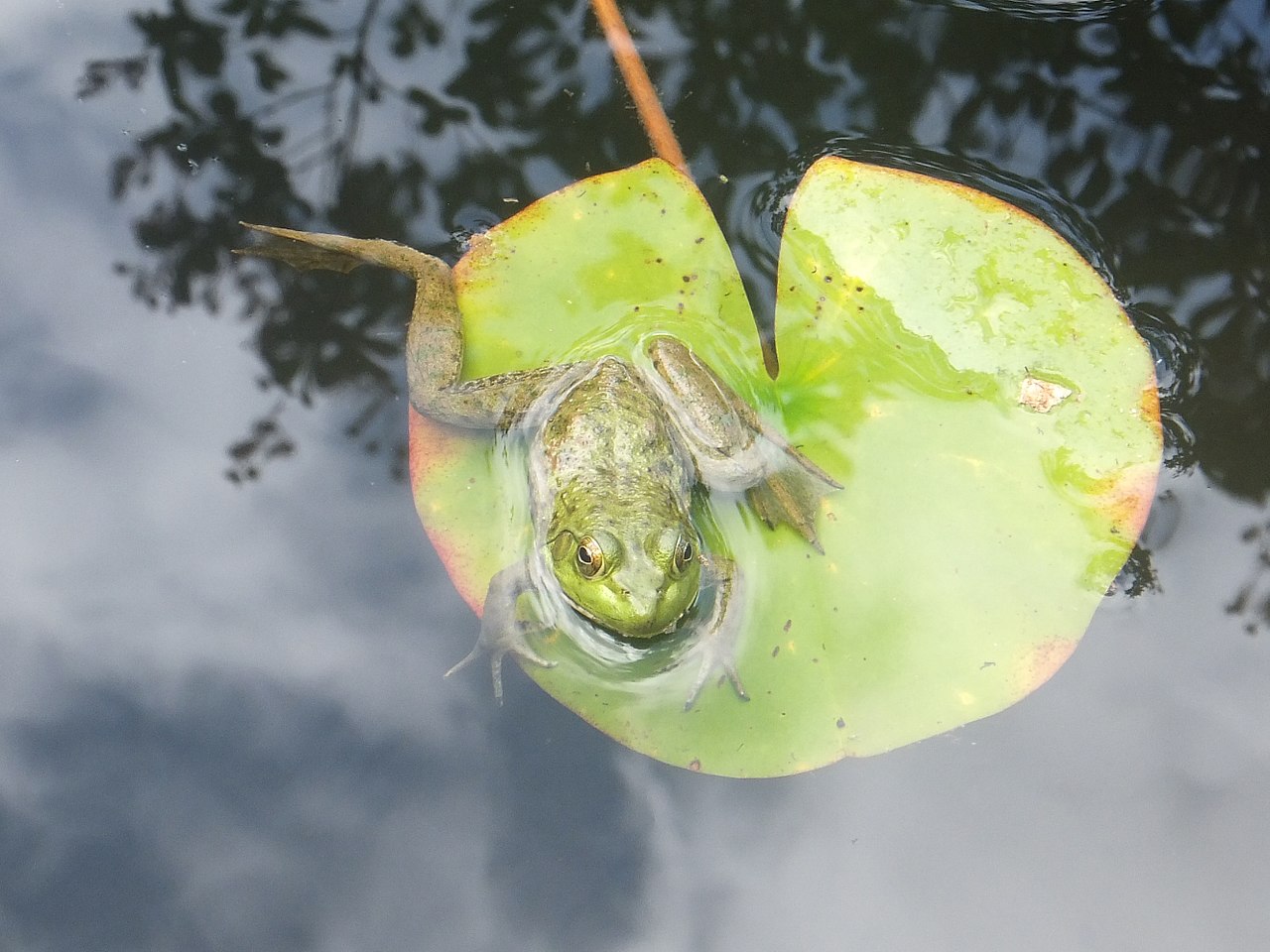
American Bullfrogs (Lithobates catesbeianus) are some of the largest types of frogs in North Carolina.
While their size varies with the habitat, these frogs grow from a size 3 inches up to a size 6 inches.
Green color with dark green dorsal overlays makes up the main morph of the species.
Male American Bullfrogs are known to form choruses where they compete for a female mate by calling.
The calls of the species inspire its name as they resemble bull bellowing. The call is low-pitched, specific to a large frog species.
Despite its large size and lazy appearance, this frog is agile as it can jump 10 times its body length.
5. Northern Cricket Frog

Northern Cricket Frogs (Acris crepitans) come in colors such as green, dark green, tan, and brown.
It lives next to streams and slow-moving waters across the state. This species feeds on almost any type of ground-dwelling insect or bug it can find.
Spiders are among the typical prey for these frogs. Northern Cricket Frogs are also food for other species as they fall prey to predatory birds.
Males of the species are known for forming large calling choruses. Females can distinguish the call of each male and tune into their frequencies.
This species has a click click call, a sound that resembles clicking rocks, pebbles, or small pieces of marble.
Muddy river banks are a common sight for these choruses, especially in areas with dense short vegetation.
6. Green Frog

Green Frogs (Lithobates clamitans) live in different habitats close to water. They inhabit areas next to streams, ponds, and lakes, preferably with vegetation.
These frogs are mid-sizes compared to other North Carolina species. They can reach a size of just under 3 inches, but many measures around 3 inches in adulthood.
Male Green Frogs show a territorial nature, both over food resources and over mates.
These frogs eat all types of small prey, including fish and insects.
Males are known for a low-pitched call that resembles banjo string plucking.
Humans are some of the biggest enemies of these frogs through industrialization and loss of habitat.
7. Pickerel Frog

Pickerel Frogs (Lithobates palustris) are the only poisonous species in North Carolina. Skin secretions are poisonous to many species and irritating to humans.
Still, there are snakes and larger frogs that can eat Pickerel Frogs as they are immune to these toxins.
The species itself has a varied diet which includes insects and larvae.
You can identify these types of frogs by the small dorsal squares which are typically brown and which make the species look different from other patterned frogs.
These types of frogs live close to the water and they share a preference for cold water habitats.
Male calls are distinctive to most species but still similar to other species that have a snor-like call. A low-pitched snor call is specific to these frogs.
8. Southern Leopard Frog
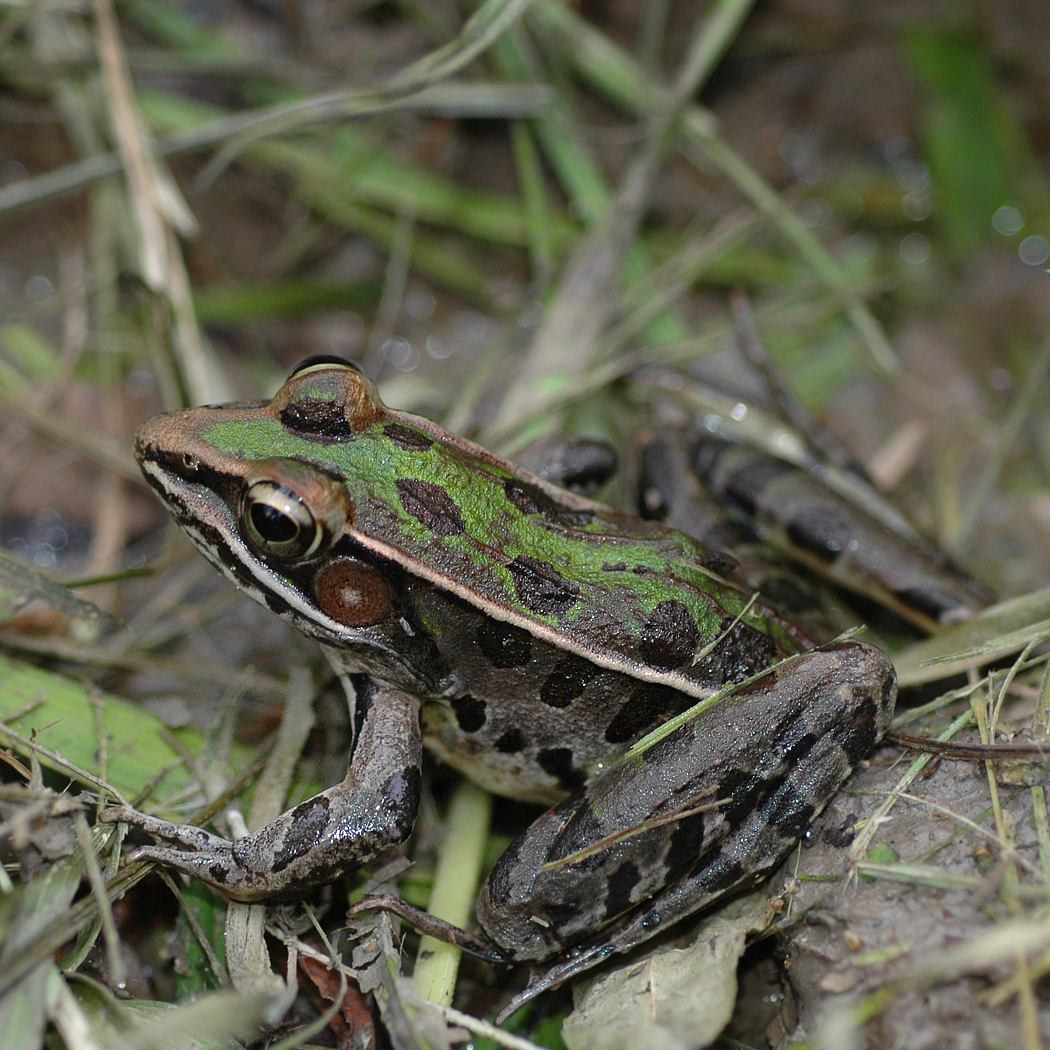
Southern Leopard Frogs (Lithobates sphenocephalus) are green or brown. A green-olive morph is widely distributed across the state.
This coloring comes with black spots on its dorsal sides which are considerably smaller than the square spots of Pickerel Frogs.
Southern Leopard Frogs are a medium to large species it grows up to a size of 5.1 inches.
Found in shallow water, the species feeds on small fish, insects, crayfish, and other soft-bodied small prey.
Active almost all year in the state, this species can also become inactive during colder months.
Its call has been described as a squeezing balloon-like call that’s sharp and repetitive.
9. Spring Peeper

Spring Peepers (Pseudacris crucifer) are a small species that can climb. While not as a good climber as other species, this frog is small and agile.
Multiple colors are specific to this species, sometimes correlated with the trees or vegetation they try to climb.
A brown-red morph is common, together with brown and green colors.
This species has nearly uniform dorsal coloring with faint black or dark patterns.
It can be found next to permanent bodies of water where it also lays eggs. It faces many predators here in its tadpole stages, including fish.
A nocturnal species, this frog eats insects if it survives to adulthood.
It gathers in choruses with a distinct chirp call. Smaller males which don’t have the same loud chirp call are known as satellites around larger males.
10. Eastern Spadefoot

Some of the most secretive but common species in the state are Eastern Spadefoot frogs (Scaphiopus holbrookii). These frogs spend most of their lives underground.
As a burrowing species, these frogs spiral down in sandy soils next to water.
The species has a muddy-green or muddy-brown color, specific to its underground living.
While not a toxic species, Eastern Spadefoot frogs have a specific muddy smell as well. The smell of the species has previously been compared to the smell of peanut butter.
Eastern Spadefoot frogs have a slow waaaah call which is repeated after a short 1-2 seconds pause.
11. Upland Chorus Frog
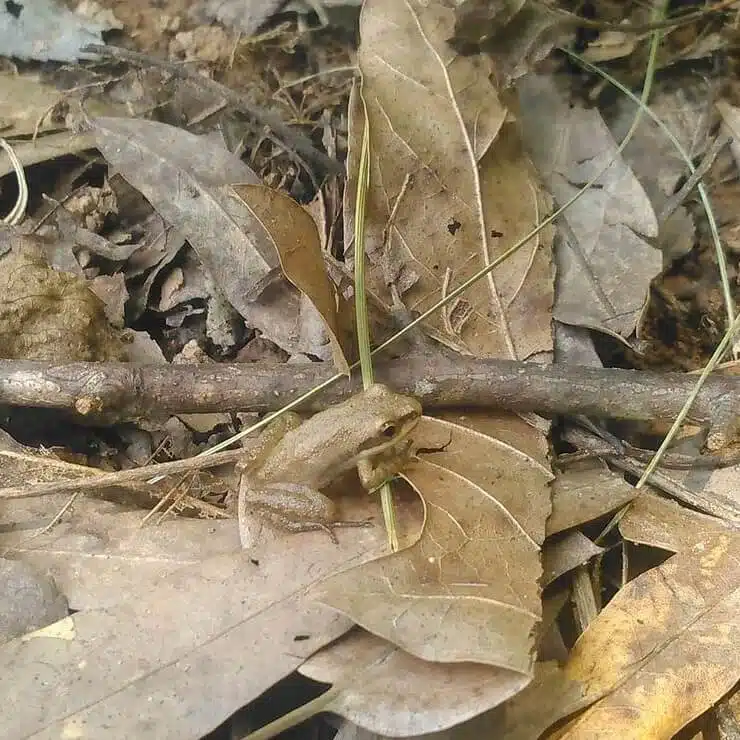
Some of the most common frogs of the Southeast are Upland Chorus Frogs (Pseudacris feriarum).
This is a small species growing up to a size of 1.5-1.7 inches which bears irregular shape stripes on its dorsum.
Most frogs of the species are gray and brown but green morphs may also be seen.
Its coloring is mostly influenced by its area, which is mostly woodlands.
This is a species with a very distinctive call that almost doesn’t resemble frogs. A trill, trill, trill sound is heard as the male calls. This is a repetitive call in 3 phases.
Upland Chorus Frogs only come out when it rains and they hide underground otherwise.
12. Southern Cricket Frog

Southern Cricket Frogs (Acris gryllus) are native to North Carolina and the Southeastern United States.
This is a species with large skin warts and dark coloring.
It has either dark olive-green coloring or brown coloring across its dorsum. A bright green mid-dorsal stripe contrasts its dark coloring.
White or off-white coloring is specific to its ventral side.
This species also comes with a brown mid-dorsal stripe morph.
A small species, this frog normally measures an average of 2.5 inches and it can be further identified by its unique call.
Male Southern Cricket Frogs have a clicking-like call. The sound resembles the noise clicking marbles make.
13. Wood Frog

Wood Frogs (Lithobates sylvaticus) are native to North American woodlands. They have a wide areal spread from Alaska to the outskirts of North Carolina.
This is a species that only lives in woodlands and which faces a diminishing habitat in areas with high industrialization.
Woodlands also influence its coloring. This ground-level hopper comes in gray, mud-gray, green, brown, and tan colors.
The colors can be uniform or patterned with darker spots.
A wa-aaak, wa-aaak call is specific to male Wood Frogs.
This species lives in a warm climate in the state but it shows high adaptability for the coldest areas of North America as well.
14. Barking Treefrog

An arboreal species, this type of frog (Hyla gratiosa) can sometimes be spotted on trees in woodlands and trees next to water sources.
It has a green body with darker green dorsal patterns and it can be identified by its barking-like call.
This type of frog uses its climbing abilities to catch insects as well as to protect itself.
It can climb and escape ground-level predators.
Unlike other treefrogs, Barking Treefrogs can also burrow to escape predatorsl.
They choose muddy soft soils next to water to go underground.
Males and females can be spotted together in a breeding pond. Some males are known to arrive first to establish territoriality.
15. Pine Woods Tree Frog

Pine Woods Tree Frogs (Hyla femoralis) are also known as The Morse Code Frogs.
This name is inspired by the very clear tick, tick, tick call of the males. It’s a type of call that resembles the sound of Morse code signals.
Pine Woods Tree Frogs have faded gray or brown coloring with dark dorsal spots.
The species has stable numbers in the state and the Southeastern part of the country.
Frogs of this species are both arboreal and terrestrial. They can climb for food but they can also come down for spiders and other insects.
16. Carpenter Frog
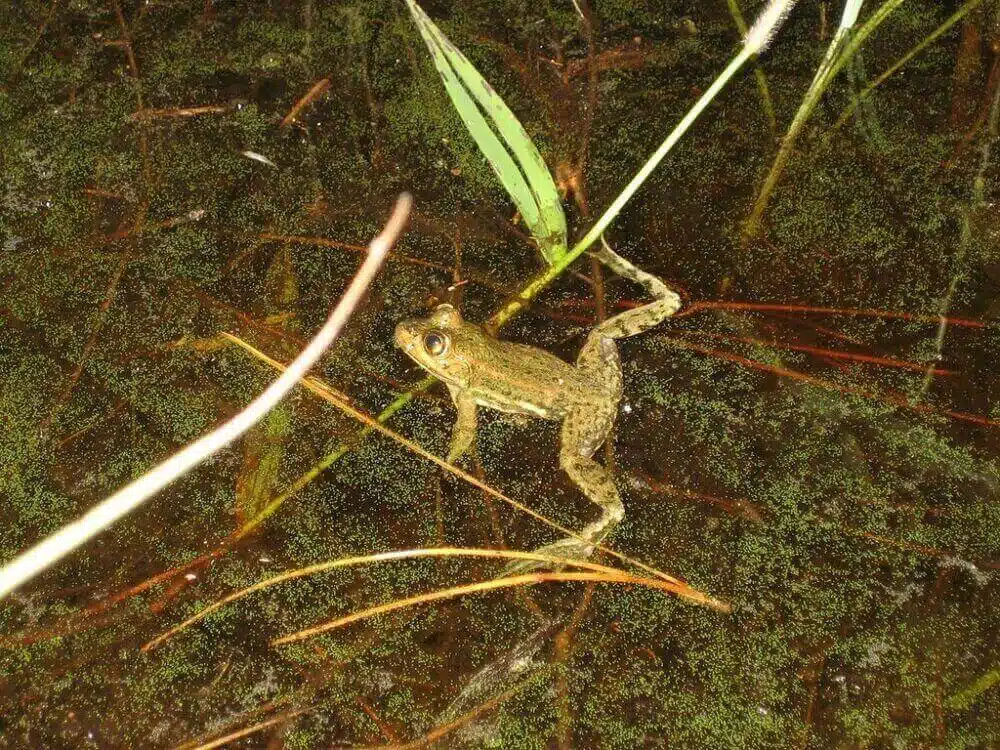
Carpenter Frogs (Lithobates virgatipes) show stable populations around different sources of water in the state.
The frog lives in cypress ponds as well as in other permanent swamps and it rarely ventures out of the water.
It prefers these areas for its safety standards when it comes to a low number of predators.
Carpenter frogs have a brown to gray color with black dorsal spots.
This is a species that’s now present in many woodlands across the state where it takes about 1 year to mature and to start reproducing.
Carpenter Frogs have a distinct call that is inspired by a carpenter’s pa-tank hammer sound.
This sound resembles the sound 2 pieces of knocking wood make.
17. Little Grass Frog

Some of the smallest types of frogs in North Carolina are Little Grass Frogs (Pseudacris ocularis).
They grow up to a size of 0.75 inches and are known for a brown or red-brown color. These small insectivores like to live both in coastal areas and next to temporary bodies of water.
While populations are stable, female Little Grass Frogs lay fewer eggs compared to other species. Up to 5 eggs are laid after mating.
Male Little Grass Frogs high a high-pitched triiil call which is repeated after short 1-second breaks.
As one of the smallest North Carolina species, Little Grass Frogs are prey for snakes and birds.
They rely on a quick escape to avoid such predators. Little Grass Frogs leap a distance of up to 20 times their body size to escape predators also making them some of the most agile in the state.
18. Pine Barrens Treefrog

A small frog species, Pine Barrens Treefrogs (Hyla andersonii) are mostly green.
Lateral dorsal brown bands contrast their bright green coloring. Only found in a few pine habitats, this is a species with a diminishing range in the Eastern parts of the US.
You may find this type of frog on land around temporary or permanent bodies of water covered in moss.
It’s here that its green coloring helps it blend in the most.
A diminishing area covered in moss is one of the main concerns when it comes to the species.
As a small species, this frog grows to a maximum of 1.4 inches. Its reduced size makes it a target for larger predators.
Its numbers are still stable in North Carolina but the species is listed as protected in South Carolina.
You can identify this type of frog by its classic waaank low-pitched call.
19. Cuban Tree Frog

A species introduced by accident to Florida, Cuban Tree Frogs (Osteopilus septentrionalis) have now made it to North Carolina.
This is an invasive species that competes with local frogs and even with other species for resources.
Tadpoles can outcompete other local tadpoles for food and limit their environment.
Adult Cuban Tree Frogs can eat small local frogs and drive their numbers down. This is a species that can grow to a large size of over 5 inches.
The high adaptability of the species is also noted in its coloring. These frogs can change colors from gray to brown or green.
This is also a species that secretes a specific type of irritating chemical from its skin. Humans experience eye-level irritation when handling the species.
A snoring-like rasp is the distinct low-pitched call of male Cuban Tree Frogs.
20. Gopher Frog

This type of frog (Lithobates capito) is facing a diminishing habitat in woodlands.
It only uses temporary bodies of water in woodland openings for reproduction. It has a distinct dark red and black color or a gray-green and brown color.
Golden stripes are sometimes seen on its dorsal sides.
These types of frogs eat different bugs such as cockroaches. They also eat spiders and other flies.
Much of their lives are spent hiding underground, coming out for food, and when it rains.
The call of male Gopher Frogs is long-lasting. It resembles a snoring sound and it lasts 2 to 3 seconds with 1-second breaks before the next call.
21. Southern Chorus Frog
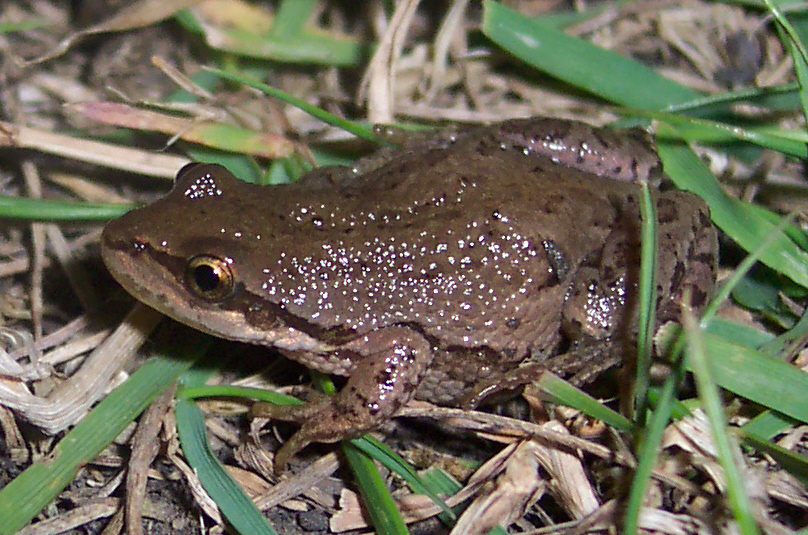
Southern Chorus Frogs (Pseudacris nigrita) have a light green, gray-green, or tan color.
Dark blotches can be seen on its dorsal side which can also be uniform in coloring until the species reaches sexual maturity.
This species also has a cream, yellow, or tan lateral stripe which is also seen on the sides of its mouth.
Southern Chorus Frogs have a different type of call compared to other species which have waaak or triiil calls.
This species has a ratchet wrench-like metallic call which is also high-pitched.
Southern Chorus frogs can be heard calling in the early days of spring into late spring.
22. Brimley’s Chorus Frog
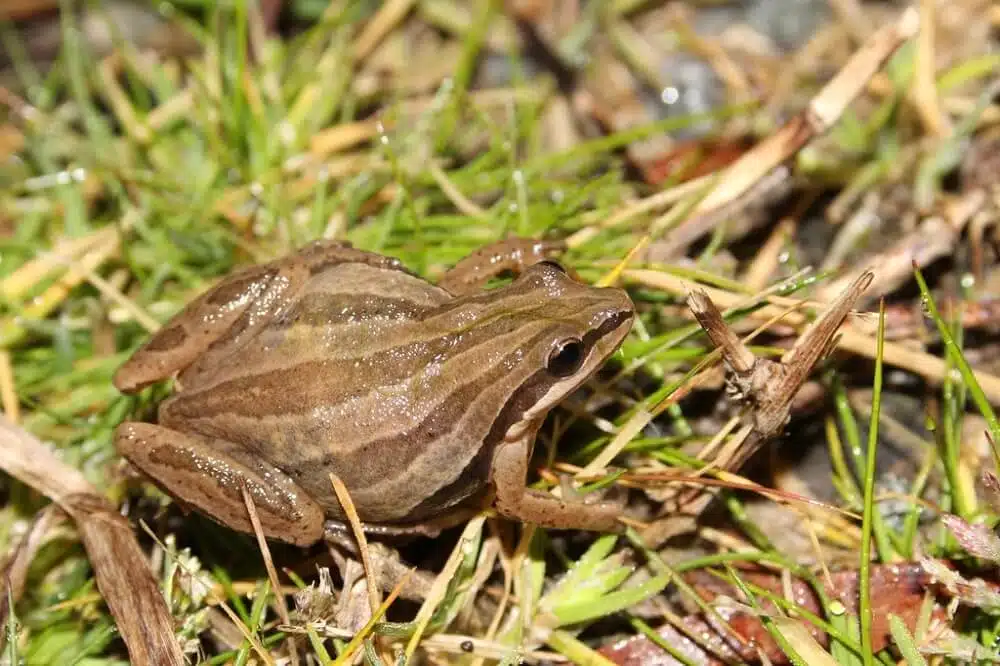
This type of chorus frog (Pseudacris brimleyi) is one of the smallest in North Carolina.
It grows to a maximum size of 1.3 inches with most adults measuring around 1 inch.
The species is commonly seen in a light brown color with dark brown dorsal patterns.
Frogs of this species are named after a renowned state naturalist, Clement Brimley.
This species has been analyzed to correctly establish its status for decades but differences in coloring made its status unclear for years.
Brimley’s Chorus Frogs are some of the loudest chorus frogs in the state. They can be heard with a triiil, triiil call in large male choruses.
Swamps are typical areas where these choruses are heard from December to late spring.
23. Atlantic Coast Leopard Frog

Atlantic Coast Leopard Frogs (Lithobates kauffeldi) are also found in North Carolina.
There are a few visible characteristics to set the species apart, such as an irregular number and the shape of black spots on its dorsal side.
The Atlantic Coast Leopard frog has a base green, olive, or gray color but all of its morphs come with black spots as well.
White and yellow lateral dorsal stripes contrast its otherwise mud-color body.
This is a species with a clear one-syllable chunk call which is repeated only after males take a short break.
The call is loud based on the male’s large vocal sac.
A long mating season is specific to Atlantic Coast Leopard Frog in North Carolina compared to the same species in Northeastern US states.
24. Ornate Chorus Frog

A small species that grows to a size of up 1.5 inches, Ornate Chorus Frogs (Pseudacris ornata) are seen in different colors.
Gray, green, and red-brown morphs are among the common colors the species is seen in.
All of these morphs show large irregular shape black spots on the sides of the body and around the mouth.
A nocturnal species, this frog is heard with a metallic-like call. It has a twink, twink call which can be repeated once or multiple times before it takes a 1-2 seconds break.
Grassy areas along woodlands are some of the most common habitats of Ornate Chorus Frogs. This species faces a loss of habitat as its major threat.
25. Gray Treefrog

Gray Treefrogs (Hyla versicolor) are among the few frogs in the state that are seen during the day.
These frogs have even adapted to rest in direct sunlight as opposed to other species that hide in moist areas underground.
You can spot these types of frogs on trees and tree branches. They take on the coloring of their habitat.
Green and gray colors are specific to this species together with lumpy skin.
A triiil call is specific to male Gray Treefrogs.
Females of the species waiting to distinguish the males with the longest calls are chosen, as mating partners.
While a species that spends much of its life on trees and shrubs, Gray Treefrogs lay eggs in temporary pools.
Male Gray Treefrogs are highly aggressive toward other males. They often live in overcrowded areas when calling to attract females directly.
26. Collinses’ Mountain Chorus Frog
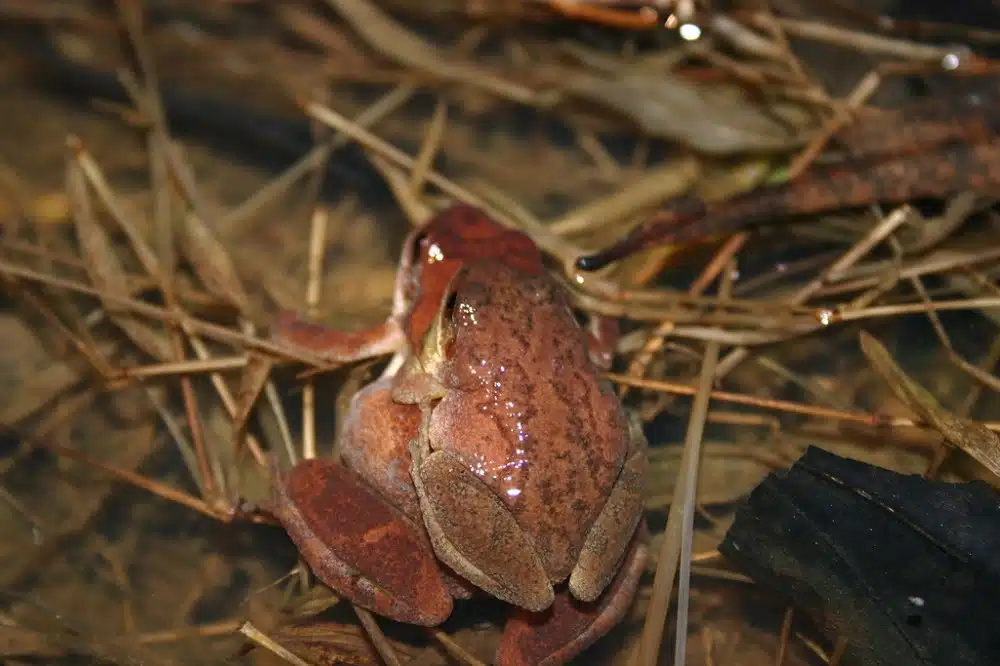
Collinses’ Mountain Chorus Frogs (Pseudacris collinsorum) are only found in hilly areas of North Carolina.
It only lives in areas of high elevation around pine woodlands. Frogs of this species only like the moist areas of pine woodlands which means they have a limited range in the state.
There’s a high color diversity tied to this species. These frogs may come patterned or with uniform green, brown, and tan colors.
Most sightings are specific to the spring and are noted up to elevations of 1.000 feet.
You can find this frog in temporary bodies of water at a higher elevation. It’s here males can be heard in small choruses with a wiiibit call.
27. Eastern Narrow-mouthed Toad

Eastern Narrow-mouthed Toads (Gastrophryne carolinensis) are large slow toads common in multiple areas of North Carolina.
Pine woodlands, oak woods, streams, and even suburban areas are habitats for the Eastern Narrow-mouthed Toad.
This is also one of the slowest-moving toads in the state. It only covers very short distances when active.
As a defense mechanism, it secretes skin toxins to avoid predators as it cannot make a quick escape.
These toxins affect the breathing of its predators and they may even irritate the nose and lungs in humans.
A large species, this toad is also known for its low-pitched call. It has a sheep bleat-like waaaah-waaah call.
Humans attracted to its call should not handle it due to the irritations it produces, breathing difficulties, and eye-level irritation.
28. American Toad

Northeastern parts of the state are home to The American Toad (Anaxyrus americanus).
This is the most common Bufonidae species in North America, with an established presence in North Carolina.
Various shades of red and brown are specific to the color of this species. A bright narrow central dorsal stripe is also seen on this species.
American Toads are among the most common species with multiple warts on their skin.
This is also a skin that releases toxins. Predators learn to stay away from the species.
Even American Toad eggs contain these toxins as the first means of protection.
Highly active from early January, this species is nocturnal and it also mates at night.
Male American Toads have some of the longest calls of all frogs and toads in North Carolina.
A buuurrrr call that lasts up to half a minute is specific to these males.
The species moves in a wide habitat after the mating season.
29. Fowler’s Toad

Fowler’s Toads (Anaxyrus fowleri) grow to a size of up to 3 inches and come in different colors.
Olive green, green, brown, and even orange and among the colors this species is seen in. Both uniform and patterned, the species can have a completely different appearance from one area to another.
This is a species that breeds multiple times in the spring, a time for new generations to be conceived.
Up to 10 broods are born each season due to the high multiplication rate of the species.
Female Fowler’s Toads also lay more eggs than other species, with at least 7.000 eggs laid after reaching sexual maturity.
It usually takes up to 1 year for the female to be ready to mate.
This species has a common long waaaah call that lasts at least a couple of seconds.
30. Southern Toad

Southern Toads (Anaxyrus terrestris) grow to a size of up to 3.6 inches. Grey, black, and red colors are all specific to these toads.
A burrowing nature is characteristic of these toads. They spend the day burrowing in the ground and only come out at night.
The first signs of these toads are seen in the spring when males get down to ponds to call for females.
A long triiiil call that lasts seconds is specific to these males.
If the species is active from spring to fall in the North, it remains active almost through the year in North Carolina.
Southern Toads are active toad species that are also seen as prey by predators.
Black racers and other snakes are among the most common Southern Toad predators.
31. Oak Toad

Oak Toads (Anaxyrus quercicus) are the smallest North American toads. A native species in North Carolina, these toads are only specific to Southeastern US territories.
These toads may be smaller than frogs as most measure anywhere between 0.7 and 1.2 inches.
A dark grey or a dark gray body is specific to Oak Toads. A bright central dorsal stripe contrasts the appearance of the species.
A species-specific to maritime woodlands, this frog also has the highest-pitched call of all North American toads.
This is a whistling-like call that repeats itself hundreds of times per minute.
Commonly spotted among pine and oak woodlands, this small species lay eggs soon after mating. Up to 500 eggs can be laid by a female Oak Toad.